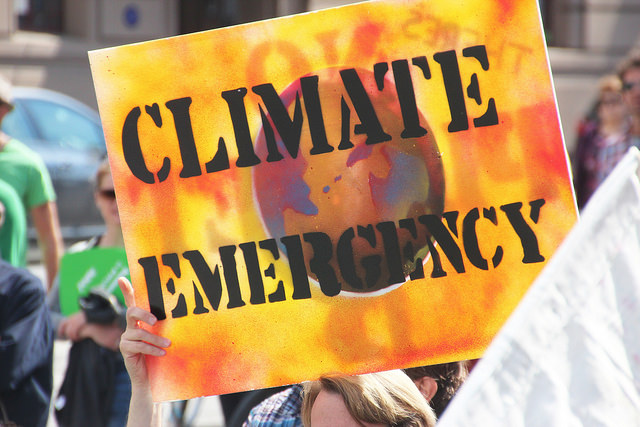
In September last year Bank of England governor Mark Carney caused a stir with a speech in which he warned of serious risk to investors from climate change. Since then, climate has been front of mind for investors and high-carbon companies alike.
Carney, who also chairs the Financial Stability Board for the G20, was met with complaints from the fossil fuel industry that they could be become “stranded assets”, abandoned by investors seeking to avoid investments particularly vulnerable to climate change issues.
Investors have indeed shown they are listening. A report indicates that they are taking “tangible action to mitigate climate change risk”, with a fifth of the largest 500 investors, and $9.4tr in funds, moving to embed the issue in their decision-making.
The report, from the Asset Owners Disclosure Project (AODP), says investors are using three key strategies for managing climate risk: tackling risk associated with high-carbon assets in their portfolios; engaging with companies they own and stakeholders; and investing in low-carbon assets.
AODP chief executive Julian Poulter said: “Climate change risk is now a mainstream issue for institutional investors, and last year has seen many significantly step up their action to manage this.”
Cooling off
Recent studies may have chilled investors. The World Bank produced numbers suggesting $158tr in assets was at risk from climate change, while the London School of Economics said the value of investment portfolios could be cut by as much as $2.5bn as a result of an average rise in temperatures of 2.5°c by the end of the century. Meanwhile, uncertainties in the calculation of “climate value at risk” means that the LSE’s academics believe the figure could also be as large as $24tr.
According to the AODP, one in ten investors are now measuring the carbon in their portfolios, up from 7% the previous year. But the AODP notes that only 2% have disclosed targets for reducing portfolio carbon.
Investors with staff dedicated to integrating climate issues into investment decisions has risen to 13%, up from 9%. Support for shareholder resolutions on climate change has grown with 12% voting for at least one, compared with 7% a year ago.
Low-carbon investment has grown 63%, from $85bn to $138bn, according to AODP figures.
The AODP also notes that “very few investors are acting on warnings from Mark Carney … that climate action could leave fossil fuel and other high-carbon investments as worthless traded assets.” It adds that 246 of the 500 investors are currently ignoring climate risk entirely.
–AODP report
A statement from the AODP quotes Christiana Figures, executive secretary of the UN Framework Convention on Climate Change, saying: “The Paris Agreement has set out the path, direction and ultimate destination for the global economy.
“Increasing numbers of asset owners understand this and more are coming to that realisation. I would encourage all of them to pick up the pace and ramp up their ambition in respect to a low-carbon transition—it is the key to reducing risk and securing the health of their portfolios now and over the long term.”
Julian Poulter says: “… only a handful are protecting their portfolios from the very real danger of stranded assets, and it is shocking that nearly half the world’s biggest investors are doing nothing at all to mitigate climate risk.
“Pensions funds and insurers that ignore climate change are gambling with the savings and financial security of hundreds of millions of people around the world and risking another financial crisis.”
Pressure on investors is certain to result in pressure on company boards. In April the power sector faced calls from investors to produce strategies in line with the Paris Agreement.
A report from the Institutional Investors Group on Climate Change called for electricity suppliers to improve governance to make it clear where climate change responsibility is on their boards and among executives, according to the website BusinessGreen.
Matthias Narr, one of the report’s authors, tells the website: “Investors need to understand whether utility companies are prepared for the changing market dynamics that are likely to arise from the policies and actions put in place to limit global warming.
“Business strategy and capital allocation decisions made now and over the coming years will determine the future sustainability and profitability of electric utilities for decades ahead.
“Investors therefore have a clear need to establish that capital allocation decisions made by the boards of these utilities give due weight to the low-carbon transition in ways that will protect both future sustainability and corporate profitability of the sector.”
On the plus side
Meanwhile, the Breaking Views website notes the upside to climate change: the $13.5tr of investment that could be required to comply with measures in the Paris Agreement.
“Some of the best financial research on climate change emanates from firms with big wealth management and high-net worth divisions like UBS, Bank of America Merrill Lynch, Morgan Stanley and HSBC,”write Antony Currie and Ben Kellerman. “Paying attention to climate change investing may help them retain the business of the younger generation of investors.”
If the AODP is right and investors are beginning collect data on carbon in their portfolios, this is likely to be only the beginning of further action. Clive Hamilton, professor of public ethics at Charles Sturt University, writes on The Conversation website: “It is true that the investors are committing only to measure and disclose the carbon footprint of their portfolios. But it’s also true that ‘what gets measured gets managed’—which in this case means, once it’s measured you have to manage it.”
–Clive Hamilton, Charles Sturt University
He adds: “The unmistakable message is that the world is changing: the major economies are beginning the transition to low-carbon energy systems, and if you are not planning for it you are not doing your job. It’s taken them a long time, but investors now get it.
“The issue is not whether they care about climate change, but whether they are properly managing risk in a changing world.”
And what of non-executive directors, generally, and their attitude to climate change risk? Last year a survey from BDO, an accountancy firm, revealed that 100% of those polled considered climate among their top three risks going forward.
But they all placed the issue third behind other risks including regulatory pressure, disruptive technology, geopolitical risk, reputational issues, information security or fraud, creditor or liquidity problems, IT, supply chain difficulties and natural disasters.
Worryingly, 45% also said they were inadequately informed about current high-profile risk topics.
Of course, one concern of non-executives may be climate change disclosure, a major issue for boards. Last year the OECD looked at reporting requirements across members states, found diverse demands and concluded that current disclosures may be of limited use.
The report says: “Whilst significant developments are being made in corporate climate change reporting, it remains a relatively young discipline facing multiple challenges associated with the fragmentation and diversity of reporting requirements, the complexity of reporting through the value chain, immature verification arrangements for non-financial information and disparity of routes through which information can be reported, all of which may limit the effective use of corporate climate change information in decision making.”




